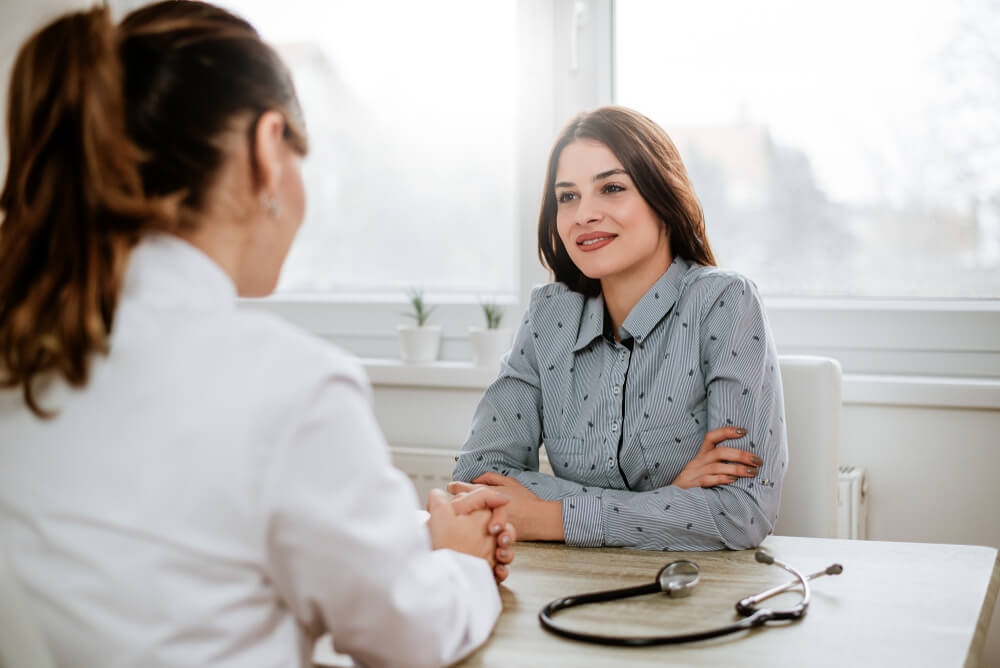Endometriosis is a medical condition that affects women. Often characterized by intense pain, it can impact your ovaries and fallopian tubes along with the pelvic lining. Though most women have wombs inside of the uterus, endometriosis occurs when the womb is outside. Learn more about the stages of endometriosis and the symptoms that you might experience before speaking to a licensed doctor about your treatment choices.
Common Endometriosis Symptoms
The most common symptom is pain. As most women experience different levels of pain, you might wonder, “what does endometriosis pain feel like?” Some women begin with minor pain that is similar to menstrual cramps. The pain can worsen over time and become almost unbearable.
You may also experience long-term or chronic pain that lasts for six months or longer. Many women notice that the pain settles in the back and lower pelvis.
The pain that you feel can become worse when you have sexual intercourse with a partner or after you finish intercourse. Many women claim that they feel this pain near the front of the vagina and that it worsens as they attempt to continue. You may also experience pain in your stomach and/or bowels. Bowel pain often worsens when you have a bowel movement.
Make sure that you consider the other symptoms, which may include bleeding and/or digestive problems. While you expect to see some blood during menstruation, women with endometriosis often notice bleeding and spotting in between their periods. Some have digestive problems that worsen when they’re on their periods, including bloating and nausea along with constipation or diarrhea. Infertility is another common symptom but one that you might not notice unless you try to get pregnant.

Stages of Endometriosis
When you speak with a doctor about vaginal endometriosis, you have the chance to learn about the different stages. The condition has four stages: minimal, mild, moderate, and severe. Doctors base the stage of a patient on factors such as how far the condition spreads through the vaginal tissues, if it affects the pelvis and whether it blocks the fallopian tubes.
You can also seek out others who have had it and ask, “what does endometriosis feel like?” This helps you compare your experiences to theirs. It can give you an idea of your current stage before speaking to your doctor.
Endometriosis Causes
Looking at the causes of endometriosis is one way to find out what caused your condition. The problem is that doctors are unsure of the exact cause.
It may occur due to problems with your tissue. Some refer to this as reverse menstruation because it does the opposite of what menstruation does. Instead of your body pushing out and expelling tissue, the tissue instead moves back and up through your body. As the tissue attaches to the vagina, your body begins absorbing it, which leads to your symptoms. Some women also develop the condition after a C-section or due to certain risk factors.
Having one or more of the top risk factors will increase your chances of developing endometriosis. One risk factor is a family history of the condition, including at least one first-degree relative who has it. A first-degree relative is someone such as your mother or sister. Women who have an abnormal uterus and those who had their first child after the age of 30 are also at risk of developing endometriosis.
Getting a Diagnosis
Telling your doctor about your symptoms is the first step to getting a diagnosis. The doctor will ask about your pain and where the pain occurs. The doctor must weed out other conditions that may cause some pain before looking at endometriosis. There are usually four methods that doctors use to diagnose the condition: ultrasound, magnetic resonance imaging, laparoscopy, and a pelvic exam.
The pelvic exam is often the first thing that a doctor will do. It allows the doctor to locate abnormal tissue and other problems that can cause your pain. Endometriosis can cause cysts to form on the ovaries, which the doctor can feel during the exam.
Ultrasound is another way that the doctor can check for signs of endometriosis. They may use an ultrasound placed on your stomach first before trying one inserted into your vagina. Though some women feel mild discomfort during the procedure, doctors can identify some of the symptoms of the condition when performing an ultrasound.
Magnetic resonance imaging is another way for doctors to diagnose your condition. Also called an MRI, this uses a machine that you sit inside while lying flat. The machine uses radio signals to map your body and find abnormalities.
Doctors will occasionally recommend that patients have a laparoscopic procedure done. You will remain asleep as a surgeon inserts tools to get a better look at the inside of your body. Not only can this find signs of endometriosis, but it can also determine the severity or stage of the condition.

Treatment for Endometriosis
Once you receive a formal diagnosis, you can talk about your treatment options. Though you cannot treat the condition at home, there are lifestyle changes that you can make to deal with your symptoms. You might try anti-inflammatory drugs that help with the pain or prescription medications if your pain is more severe. Some women find it helpful to take birth control medications that reduce the bleeding they experience during their periods. Birth control medications can also help with cramps.
If your symptoms persist or worsen, your doctor might recommend laser treatment for endometriosis. This is a laparoscopic procedure that allows the doctor to look for cysts along with any scarring. It can work after you try hormone therapy or along with that therapy. Doctors will only use this treatment if you already received a diagnosis.
Roughly 60 to 80% of women who went through the procedure reported a reduction in their overall pain. Around 50% of patients found that some of their symptoms returned up to two years later.
Laser treatment for endometriosis is a good option for women who did not get relief from other treatments. The doctor can use the procedure to remove scar tissue that causes pain and implants that might affect your fertility. You can also have cysts removed at the same time.
Treat Your Endometriosis Today
Is this information useful? The pain that you feel from endometriosis doesn’t have to affect your life or stop you from doing the things that you love. You need a diagnosis to help you get the treatment that you need.
Dr. Andrew Krinsky can provide help and relief from endometriosis. Get the diagnosis that you want before talking about treatments such as laser treatment and hormone therapy. Call today to make your first appointment to talk to Dr. Krinsky and start down your road to recovery.


